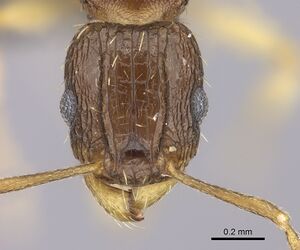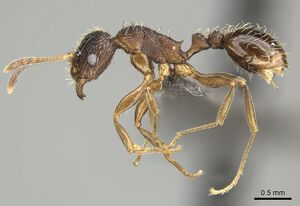Tetramorium frenchi
| Tetramorium frenchi | |
|---|---|

| |
| Scientific classification | |
| Kingdom: | Animalia |
| Phylum: | Arthropoda |
| Class: | Insecta |
| Order: | Hymenoptera |
| Family: | Formicidae |
| Subfamily: | Myrmicinae |
| Tribe: | Crematogastrini |
| Genus: | Tetramorium |
| Species: | T. frenchi |
| Binomial name | |
| Tetramorium frenchi Forel, 1914 | |
This species occurs in a wide range of habitats, from grassland to forest. It is apparently ground-dwelling, as it has been collected from pitfall trap samples, under rocks, and a rotten log.
Identification
Bolton (1980) - This small, dark species is most closely related to Tetramorium avium but is distinguished from it by the structure of the petiole, presence of gastral sculpture and stronger rugosity on the alitrunk, as discussed under T. avium. More distantly T. frenchi is related to Tetramorium laevithorax but in the latter the alitrunk is mostly or entirely unsculptured and shining.
Keys including this Species
Distribution
Latitudinal Distribution Pattern
Latitudinal Range: -8.21101° to -34.4°.
| North Temperate |
North Subtropical |
Tropical | South Subtropical |
South Temperate |
- Source: AntMaps
Distribution based on Regional Taxon Lists
Afrotropical Region: South Africa (type locality), United Republic of Tanzania, Zimbabwe.
Distribution based on AntMaps
Distribution based on AntWeb specimens
Check data from AntWeb
Countries Occupied
| Number of countries occupied by this species based on AntWiki Regional Taxon Lists. In general, fewer countries occupied indicates a narrower range, while more countries indicates a more widespread species. |

|
Estimated Abundance
| Relative abundance based on number of AntMaps records per species (this species within the purple bar). Fewer records (to the left) indicates a less abundant/encountered species while more records (to the right) indicates more abundant/encountered species. |

|
Biology
Castes
Worker
Images from AntWeb
   
| |
| Worker. Specimen code casent0235769. Photographer Shannon Hartman, uploaded by California Academy of Sciences. | Owned by AFRC, Pretoria, South Africa. |
   
| |
| Worker. Specimen code casent0235780. Photographer Shannon Hartman, uploaded by California Academy of Sciences. | Owned by AFRC, Pretoria, South Africa. |
   
| |
| Worker. Specimen code casent0249021. Photographer Ryan Perry, uploaded by California Academy of Sciences. | Owned by AFRC, Pretoria, South Africa. |
   
| |
| Syntype of Tetramorium frenchi. Worker. Specimen code casent0909132. Photographer Will Ericson, uploaded by California Academy of Sciences. | Owned by MHNG, Geneva, Switzerland. |
Queen
Images from AntWeb
   
| |
| Queen (alate/dealate). Specimen code casent0100798. Photographer Will Ericson, uploaded by California Academy of Sciences. | Owned by CAS, San Francisco, CA, USA. |
Nomenclature
The following information is derived from Barry Bolton's Online Catalogue of the Ants of the World.
- frenchi. Tetramorium frenchi Forel, 1914d: 229 (w.) SOUTH AFRICA. See also: Bolton, 1980: 278.
Worker
Bolton (1980) - TL 2.9-3.4, HL 0.68-0.80, HW 0.58-0.66, CI 81-86, SL 0.62-0.70, SI 106-116, PW 0.42-0.52, AL 0.84-1.00 (20 measured).
Mandibles longitudinally striate. Anterior clypeal margin entire, without a median notch or impression. Frontal carinae reaching back almost to occiput, strongly developed, surmounted by a narrow raised rim or crest and more strongly developed than the remaining cephalic sculpture. Antennal scrobes weakly developed and shallow. Antennal scapes relatively long, SI > 100. Maximum diameter of eye 0.16-0.18, about 0.26-0.28 x HW. Alitrunk in profile with metanotal groove feebly or not impressed. Propodeal spines short and acute, longer than the broadly triangular metapleural lobes, but not as long as the maximum diameter of the eye. Petiole in profile with a long anterior peduncle and a sharply defined node. The anterior and posterior faces very slightly or not convergent from base of node to apex and the anterodorsal angle a sharp right-angle, often projecting into a low peak or crest. Posterodorsal angle not as sharp as anterodorsal but not broadly rounded. Petiole node in dorsal view obviously much broader than long. Dorsum of head longitudinally rugulose, often with a few feeble cross-meshes behind the level of the eyes but without a rugoreticulum occipitally. Ground-sculpture of head a superficial but fairly conspicuous granulation or punctulation, much more obvious on the sides above the eyes than on the dorsum. Dorsum of alitrunk densely rugulose, forming a loose and disorganized reticulum on the pronotum and sometimes also elsewhere. Ground-sculpture between the rugulae of moderately distinct fine punctulation. Dorsal surfaces of petiole and postpetiole finely and densely rugulose with distinct fine punctulation between the rugulae. Base of first gastral tergite with a band of fine punctulation or shagreening, usually distinct but faint in a few individuals. All dorsal surfaces of head and body with numerous standing hairs which are quite stout and tend to be blunted apically. Antennal scapes and tibiae of mid and hind legs only with short, fine, decumbent to appressed pubescence. Colour uniform dark brown to blackish brown.
Type Material
Bolton (1980) - Syntype workers, South Africa: Natal, Durban, Krantz Kloof, 24.v.1914, no. 318 (H. W. B. Marley) (Natural History Museum of Zimbabwe; MHNG) [examined].
References
- Bolton, B. 1980. The ant tribe Tetramoriini (Hymenoptera: Formicidae). The genus Tetramorium Mayr in the Ethiopian zoogeographical region. Bulletin of the British Museum (Natural History) Entomology. 40(3):193-384.
- Forel, A. 1914d. Formicides d'Afrique et d'Amérique nouveaux ou peu connus. Bull. Soc. Vaudoise Sci. Nat. 50: 211-288 (page 229, worker described)
References based on Global Ant Biodiversity Informatics
- IZIKO South Africa Museum Collection

